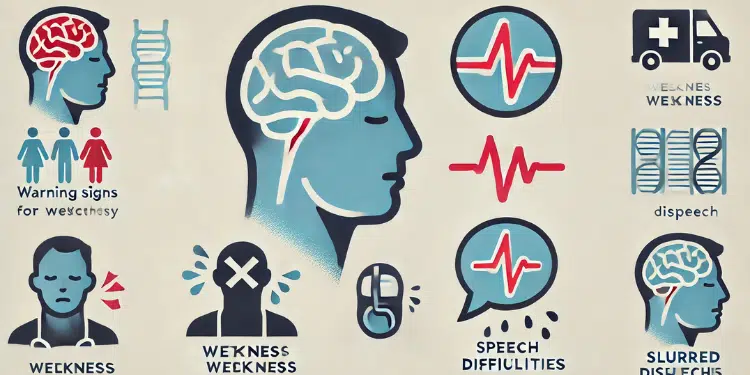Strokes are among the leading causes of disability and death worldwide. Every year, millions of people experience a stroke, and for many, the consequences are life-altering. But what if you could spot the warning signs of a stroke up to a week before it happens? While not every stroke comes with early symptoms, research and patient reports reveal that many people do experience subtle, sometimes overlooked, warning signs in the days leading up to a stroke. Recognizing these symptoms and seeking immediate medical attention can make a crucial difference in outcomes—potentially saving your life or the life of someone you love.
In this comprehensive guide, we’ll explore the 10 most common warning signs of a stroke that can appear up to a week before the event, explain why these symptoms occur, and provide practical advice on what to do if you notice them.
Understanding Stroke: The Basics
A stroke occurs when blood flow to a part of the brain is interrupted, either by a blockage (ischemic stroke) or by bleeding (hemorrhagic stroke). Without oxygen-rich blood, brain cells begin to die within minutes, which is why strokes are medical emergencies. The sooner a stroke is treated, the better the chances of survival and recovery.
Types of Stroke
-
Ischemic Stroke: Caused by a blood clot blocking a blood vessel in the brain (about 87% of all strokes).
-
Hemorrhagic Stroke: Caused by a blood vessel rupturing and bleeding into the brain.
-
Transient Ischemic Attack (TIA): Often called a “mini-stroke,” TIAs are temporary blockages that resolve on their own but are major warning signs for a future stroke.
Why Early Warning Signs Matter
While strokes often strike suddenly, many people report experiencing symptoms in the days or even weeks before the main event. These early warning signs—sometimes called “pre-stroke” symptoms—are often due to small, temporary interruptions in blood flow to the brain. By recognizing and acting on these signs, you can seek medical attention before a full-blown stroke occurs, potentially preventing serious brain damage.
The 10 Warning Signs of a Stroke a Week Before
1. Sudden Weakness or Numbness
What to Watch For:
Unexplained weakness or numbness, especially on one side of the body (face, arm, or leg).
Why It Happens:
A temporary reduction in blood flow can affect the nerves controlling muscle movement and sensation.
What to Do:
If you notice sudden, unexplained weakness or numbness—especially if it comes and goes—seek medical attention immediately.
2. Trouble Speaking or Understanding Speech
What to Watch For:
Slurred speech, difficulty finding words, or trouble understanding what others are saying.
Why It Happens:
Parts of the brain responsible for language may be affected by reduced blood flow.
What to Do:
If you or someone else suddenly has trouble speaking or understanding language, call emergency services.
3. Sudden Vision Problems
What to Watch For:
Blurred or double vision, loss of vision in one or both eyes, or seeing flashing lights.
Why It Happens:
The brain’s visual processing centers may be deprived of oxygen.
What to Do:
Any sudden change in vision should be treated as an emergency.
4. Severe, Unexplained Headache
What to Watch For:
A sudden, severe headache with no known cause, sometimes described as the “worst headache of your life.”
Why It Happens:
A hemorrhagic stroke or a TIA can cause sudden changes in blood pressure or bleeding in the brain.
What to Do:
Seek immediate medical care, especially if the headache is accompanied by other symptoms.
5. Dizziness, Loss of Balance, or Coordination Problems
What to Watch For:
Sudden dizziness, trouble walking, loss of balance, or unexplained falls.
Why It Happens:
The cerebellum, which controls balance and coordination, may be affected by reduced blood flow.
What to Do:
If you experience these symptoms, especially with other warning signs, get medical help right away.
6. Sudden Confusion or Trouble Understanding
What to Watch For:
Becoming suddenly confused, disoriented, or unable to follow simple instructions.
Why It Happens:
Reduced blood flow can impair cognitive functions.
What to Do:
Do not ignore sudden confusion—seek emergency care.
7. Sudden Difficulty Swallowing
What to Watch For:
Choking, coughing, or trouble swallowing food or liquids.
Why It Happens:
Stroke can affect the muscles used for swallowing.
What to Do:
Difficulty swallowing can lead to choking and aspiration—seek immediate help.
8. Sudden Nausea or Vomiting
What to Watch For:
Nausea or vomiting without an obvious cause, especially if accompanied by dizziness or headache.
Why It Happens:
Strokes affecting the brainstem can disrupt the body’s normal regulation of nausea and vomiting.
What to Do:
Persistent, unexplained nausea or vomiting should be evaluated by a doctor.
9. Transient Ischemic Attack (TIA) Symptoms
What to Watch For:
Brief episodes of any of the above symptoms that resolve within minutes or hours.
Why It Happens:
A TIA is a “mini-stroke” that temporarily blocks blood flow but doesn’t cause permanent damage.
What to Do:
A TIA is a major warning sign—a full stroke may follow within days. Always treat a TIA as a medical emergency.
10. Unusual Fatigue or Mental Fog
What to Watch For:
Sudden, unexplained fatigue, sleepiness, or mental fog that doesn’t improve with rest.
Why It Happens:
The brain may not be getting enough oxygen, leading to decreased alertness and energy.
What to Do:
If you experience sudden, severe fatigue—especially with other symptoms—seek medical attention.
Recognizing the FAST Signs
In addition to the symptoms above, remember the FAST acronym for stroke:
-
Face drooping: Is one side of the face numb or drooping?
-
Arm weakness: Is one arm weak or numb?
-
Speech difficulty: Is speech slurred or hard to understand?
-
Time to call emergency services: If any of these signs are present, call for help immediately.
Who Is at Risk?
Anyone can have a stroke, but certain factors increase your risk:
-
High blood pressure
-
Diabetes
-
High cholesterol
-
Smoking
-
Obesity
-
Sedentary lifestyle
-
Family history of stroke
-
Heart disease
-
Excessive alcohol consumption
-
Age (risk increases with age)
If you have any of these risk factors, be especially vigilant for warning signs.
What to Do If You Notice Warning Signs
Don’t wait.
Time is brain—every minute counts. If you or someone you know experiences any of the warning signs above, call emergency services immediately. Do not attempt to drive yourself to the hospital.
Do not ignore symptoms, even if they go away.
Symptoms that resolve on their own may be a TIA, which is a serious warning that a major stroke could occur soon.
Write down the time.
Knowing when symptoms began can help doctors choose the best treatment.
Can Strokes Be Prevented?
While not all strokes can be prevented, you can greatly reduce your risk by:
-
Managing blood pressure, cholesterol, and diabetes
-
Eating a healthy diet
-
Exercising regularly
-
Not smoking
-
Limiting alcohol
-
Managing stress
-
Taking prescribed medications as directed
Regular check-ups and open communication with your healthcare provider are essential.
The Importance of Early Detection
Many people dismiss early warning signs as stress, fatigue, or minor illness. However, studies show that up to 43% of stroke patients experience warning symptoms in the week before their stroke. Recognizing and acting on these symptoms can lead to early intervention, which may prevent a major stroke or reduce its severity.
Conclusion
Strokes can be devastating, but they are not always sudden and unpredictable. By learning to recognize the 10 warning signs that can appear up to a week before a stroke, you empower yourself and your loved ones to act quickly and potentially prevent life-changing consequences. Remember: sudden weakness, speech problems, vision changes, severe headaches, dizziness, confusion, swallowing issues, unexplained nausea, TIA symptoms, and unusual fatigue are all red flags.
If you notice any of these symptoms, especially if you have risk factors for stroke, seek emergency medical care immediately. Your vigilance could save your life or the life of someone you care about.
References:
-
American Stroke Association. Stroke Warning Signs and Symptoms
-
Mayo Clinic. Stroke: Symptoms and Causes
-
National Institutes of Health. Warning Signs of Stroke
-
WebMD. 10 Signs of Stroke
This article is for informational purposes only and does not constitute medical advice. Always consult a healthcare professional if you suspect a stroke or experience any concerning symptoms.



